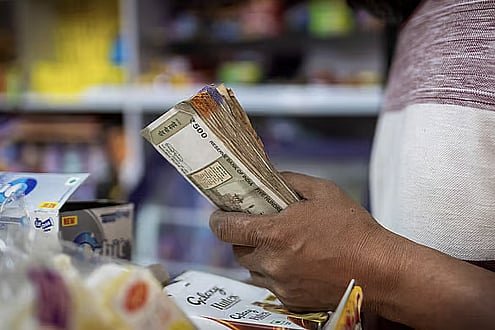The Indian rupee is facing fresh pressure, hovering around Rs87.55 – Rs87.66 per US dollar, as a resurgent dollar index, hefty new tariffs on Indian exports to the US, and continued foreign money outflows weigh on the currency’s outlook.
According to market data, one US dollar now fetches approximately Rs87.55 to Rs87.66 in onshore trading, with the Reserve Bank of India (RBI) stepping in frequently to stem volatility.
Against the UAE dirham, the rupee trades at around Rs23.80 per Dh1—reflecting modest weakening, with one rupee equivalent to just 0.0419 dirham.
Over the past five years, the rupee has depreciated steadily — from approximately Rs74 per dollar in mid-2020, to breaking past Rs79 by 2022 amid surging crude and US rate hikes, and edging close to Rs83 in 2024 amid global recession fears. This year’s slide to the 87-plus mark represents a cumulative decline of more than 13 per cent.
The immediate pressure stems from a strong recovery in the US dollar, driven by safe-haven demand and expectations of further US Federal Reserve rate cuts, which are increasing demand for greenbacks and weighing on emerging market currencies like the rupee.
Compounding this is the Trump administration’s decision to impose 25 per cent tariffs and another 25 per cent of punitive tariffs on a wide range of Indian exports — textiles, gems, leather and chemicals — which is eroding export competitiveness and rattling investor confidence. The rupee marked its worst six-week losing streak in half a year as a result.
Foreign investors have pulled more than $4-$10 billion from Indian equities and debt this year, while the RBI has spent over $9 billion to defend the currency through spot and non-deliverable forward (NDF) market interventions.
“Tariffs of this magnitude are not just a trade story — they are a currency story,” warns Vivek Mittal, head of Asia currency strategy at First Global Research.
While India’s growth fundamentals remain relatively strong — with GDP growth above six per cent and forex reserves exceeding $650 billion —experts caution that the rupee will remain sensitive to global monetary policies and capital flows. Priya Nair, senior economist at Axis Capital, notes: “Even with robust domestic growth, if external factors like US tariffs, stronger dollar trends…come into play, the rupee will adjust to reflect those risks.”
Non-deliverable forward (NDF) markets suggest a modest pull-back, with the rupee expected to open in the Rs87.52–Rs87.56 range — slightly firmer than recent trading — as RBI interventions temper expectations.
However, structural risks remain intact. Unless the administration softens its tariff stance or US inflation surprises to the downside prompting dovish Fed moves, the rupee is unlikely to regain strength. “From day to day, we learn more about new rules that could dramatically change the landscape,” said Darwei Kung, head of commodities at DWS Group.
Forward indicators signal continued volatility: one-month implied volatility in USD/INR is nearing its annual peak, and option markets show rising demand for protection against a slide toward Rs85.
The rupee remains in a vulnerable zone, with limited upside in the near term absent relief on tariffs or global dollar trends. Structural pressures from external shocks may keep the currency under pressure, with key support levels being tested and sentiment remaining fragile.
